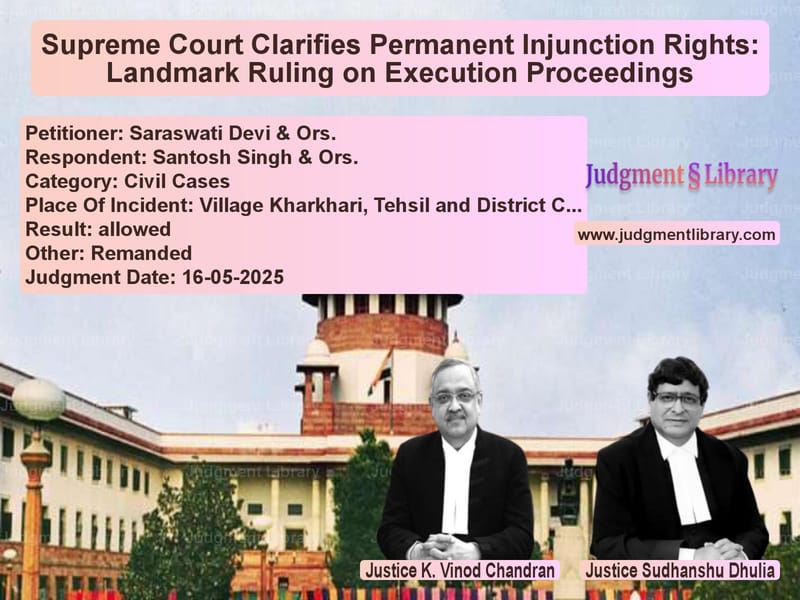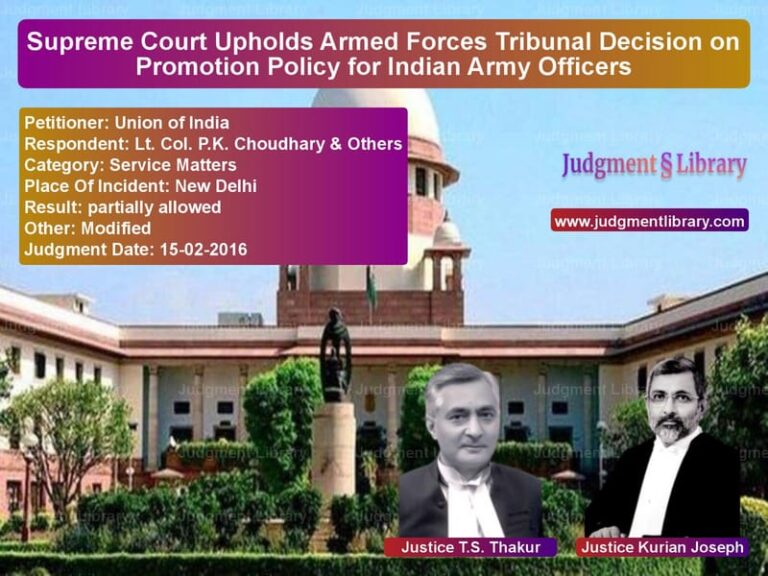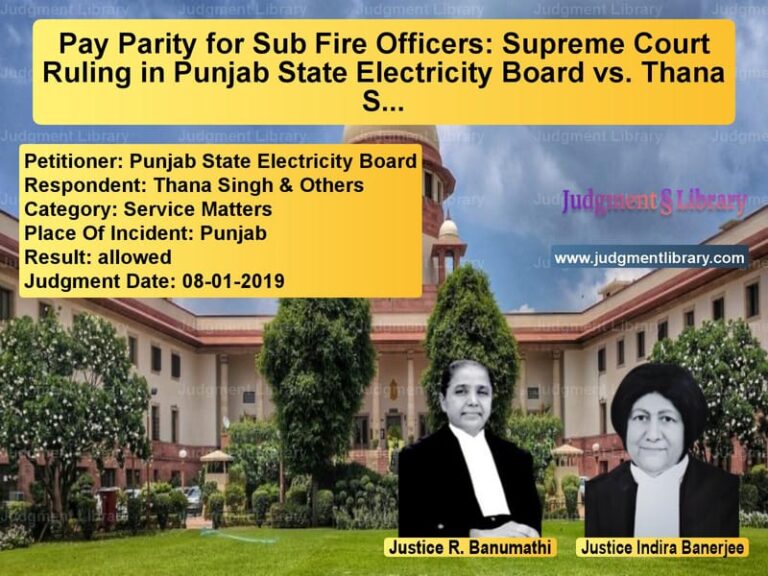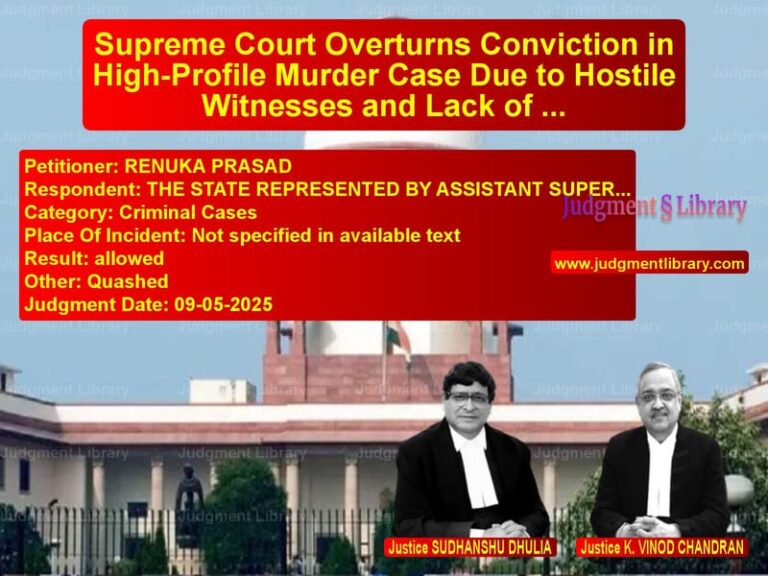Supreme Court Clarifies Permanent Injunction Rights: Landmark Ruling on Execution Proceedings
In a significant judgment that clarifies the legal rights of property owners holding permanent injunction decrees, the Supreme Court has delivered a landmark ruling that protects the perpetual nature of injunction orders. The case involved a long-standing property dispute from Uttarakhand that had been winding through the Indian judicial system for decades, highlighting the complexities of execution proceedings and the enforcement of court decrees.
The legal saga began in 1988 when the predecessor-in-interest of the appellants filed Civil Suit No. 44 of 1988 against the respondents. After twelve years of litigation, the court delivered a decisive judgment in 2000, granting the plaintiffs a permanent prohibitory injunction that prevented the defendants from interfering with their peaceful possession of agricultural fields numbered 4810-4811 situated in Village Kharkhari, Tehsil and District Champawat. The court also cancelled a supplementary sale deed dated August 22, 1998, that had been issued in favor of the defendants’ family members.
However, obtaining the decree proved to be only half the battle. The real challenge began when the decree-holders attempted to enforce their rights through execution proceedings, leading to a complex legal web that eventually reached the Supreme Court after multiple failed attempts in lower courts.
The Execution Proceedings Saga
The first execution petition was filed by the original plaintiffs when they faced obstruction from the judgment-debtors. This initial EP was closed when both parties failed to appear before the court. The judgment-debtors had submitted a written undertaking stating they were not causing any obstruction or interference, and the court, noting the absence of the decree-holder, recorded “full satisfaction” and closed the case.
A second execution petition was filed but was not pressed by the decree-holders. The crucial third execution proceedings were initiated by the legal heirs of the original plaintiffs – the appellants in the Supreme Court case. They filed EP No. 2 of 2012, seeking to enforce the permanent injunction decree they had inherited.
The judgment-debtors raised objections under Section 47 of the Code of Civil Procedure, 1908, arguing that they were asserting title based on a sale deed dated September 29, 1984, and that only the supplemental deed of 1998 had been cancelled in the original decree. They also claimed to have filed an application before the Civil Judge to set aside the original decree dated July 19, 2000.
The Executing Court considered these objections but ultimately ruled against the decree-holders, stating that since the earlier EP had been disposed of on grounds of “full satisfaction,” there was no scope for further execution proceedings. This decision was affirmed by the revisional court, and when the decree-holders approached the High Court through a writ petition, their case was dismissed. The High Court also dismissed their review petition, leading to the appeal before the Supreme Court.
The Supreme Court’s Critical Analysis
The Supreme Court bench comprising Justices Sudhanshu Dhulia and K. Vinod Chandran began its analysis with a stark observation about the High Court’s handling of the case. The Court stated that “We cannot but, at the outset, indicate that the High Court has misconstrued the entire case.” This strong opening remark set the tone for a judgment that would systematically dismantle the legal errors committed by the lower courts.
The Court noted that “The High Court clearly misconstrued the facts and misunderstood the orders impugned in the writ petition, and the writ petition filed by the decree holder against the dismissal of his EP was dismissed finding the objection of the judgment holder to be unsustainable.” This fundamental misunderstanding of the case’s nature formed the basis of the Supreme Court’s intervention.
The Core Legal Principles
The Supreme Court delivered a masterclass in the law governing permanent injunctions and execution proceedings. The Court made several crucial observations that clarify important legal principles.
Regarding the nature of permanent injunction decrees, the Court stated that “The decree was one of permanent prohibitory injunction from interference to the peaceful possession of the scheduled property. A satisfaction recorded in one EP would not result in the dismissal of a further EP filed on the ground of a subsequent interference caused.”
This observation strikes at the heart of the lower courts’ error. The Supreme Court clarified that recording satisfaction in one execution petition does not extinguish the decree-holder’s rights permanently. Each fresh instance of interference gives rise to a new cause of action for enforcement of the permanent injunction.
The Court then turned to the Limitation Act, 1963, providing what would become the most significant legal clarification in the judgment. The Court stated that “Article 136 of the Schedule to the Limitation Act, 1963 provides for limitation, for execution of any decree other than a decree granting a mandatory injunction or the order of any Civil Court. While 12 years is provided as the period of limitation the proviso specifically provides that there would be no limitation to enforce or execute a decree granting perpetual injunction.”
This interpretation of the law has far-reaching implications. The Court explained that “When a permanent injunction is granted it operates perpetually against the judgment debtors, their assignees and successors and it could be enforced at any time, breach is occasioned. The decree-holder; their assignees and successors, has a perpetual right in personam against the decree holders their assignees and successors.”
The concept of “perpetual right in personam” is particularly significant. It means that the right created by a permanent injunction decree is a personal right that continues indefinitely against the specific individuals named in the decree and their successors. This right can be enforced whenever a breach occurs, regardless of how much time has passed since the original decree.
Practical Implications of the Judgment
The Supreme Court’s ruling has several important practical implications for property owners and legal practitioners. First, it reaffirms that permanent injunction decrees are not one-time remedies but ongoing protections that can be enforced repeatedly as long as the protected right exists.
Second, the judgment clarifies that the principle of res judicata, which prevents the same matter from being litigated repeatedly, does not apply to fresh instances of interference with rights protected by permanent injunctions. Each new act of interference creates a separate cause of action that can be pursued through execution proceedings.
Third, the Court has firmly established that there is no time limit for enforcing permanent injunction decrees. While most civil decrees must be executed within 12 years under Article 136 of the Limitation Act, permanent injunctions enjoy a special status that allows for enforcement at any time a breach occurs.
The Supreme Court’s Final Directions
Having identified the legal errors in the lower courts’ decisions, the Supreme Court proceeded to provide clear directions for the resolution of the case. The Court stated that “We find the order of the High Court to be flawed, and the order of the executing Court as affirmed by the revisional Court also to be bad and we set aside the orders. The EP shall stand restored.”
The Court showed judicial restraint by making it clear that its observations regarding the claims raised under Section 47 of the CPC were only prima facie and would not govern the executing court’s consideration of such objections. The Court also allowed the judgment-debtors to produce before the executing court the result of the proceedings they had initiated for cancellation of the decree.
The Supreme Court remitted the case back to the Court of Civil Judge, Senior Division, Champaran, with directions that EP No. 2 of 2012 would stand restored and be considered afresh in light of the Supreme Court’s findings. However, the Court specifically excluded from its remit the issues regarding the sustainability of the decree and the contention regarding the cancellation proceedings, leaving these matters for the executing court to decide.
Broader Legal Significance
This judgment serves as an important reminder of the powerful protection offered by permanent injunction decrees in Indian property law. It reinforces the principle that when a court grants a permanent injunction, it creates a lasting right that continues to protect the decree-holder against future violations.
The ruling also highlights the importance of proper legal understanding in execution proceedings. The fact that multiple courts, including the High Court, misapplied fundamental legal principles demonstrates the complexity of execution jurisprudence and the need for careful legal analysis in such matters.
For property owners across India, this judgment provides reassurance that their rights, once established through a permanent injunction decree, enjoy robust and lasting protection under Indian law. The Supreme Court has made it clear that such decrees are not mere paper judgments but living protections that can be activated whenever needed to prevent interference with legally established rights.
The appeals were allowed with the above observations and reservations, bringing to a close a legal battle that had stretched across decades and multiple generations of litigants. The Supreme Court’s clear and principled judgment not only provided justice to the specific parties involved but also created valuable legal precedent that will guide lower courts in similar cases for years to come.
Petitioner Name: Saraswati Devi & Ors..Respondent Name: Santosh Singh & Ors..Judgment By: Justice K. Vinod Chandran, Justice Sudhanshu Dhulia.Place Of Incident: Village Kharkhari, Tehsil and District Champawat, Uttarakhand.Judgment Date: 16-05-2025.Result: allowed.
Don’t miss out on the full details! Download the complete judgment in PDF format below and gain valuable insights instantly!
Download Judgment: saraswati-devi-&-ors-vs-santosh-singh-&-ors.-supreme-court-of-india-judgment-dated-16-05-2025.pdf
Directly Download Judgment: Directly download this Judgment
See all petitions in Property Disputes
See all petitions in Judgment by K. Vinod Chandran
See all petitions in Judgment by Sudhanshu Dhulia
See all petitions in allowed
See all petitions in Remanded
See all petitions in supreme court of India judgments May 2025
See all petitions in 2025 judgments
See all posts in Civil Cases Category
See all allowed petitions in Civil Cases Category
See all Dismissed petitions in Civil Cases Category
See all partially allowed petitions in Civil Cases Category







